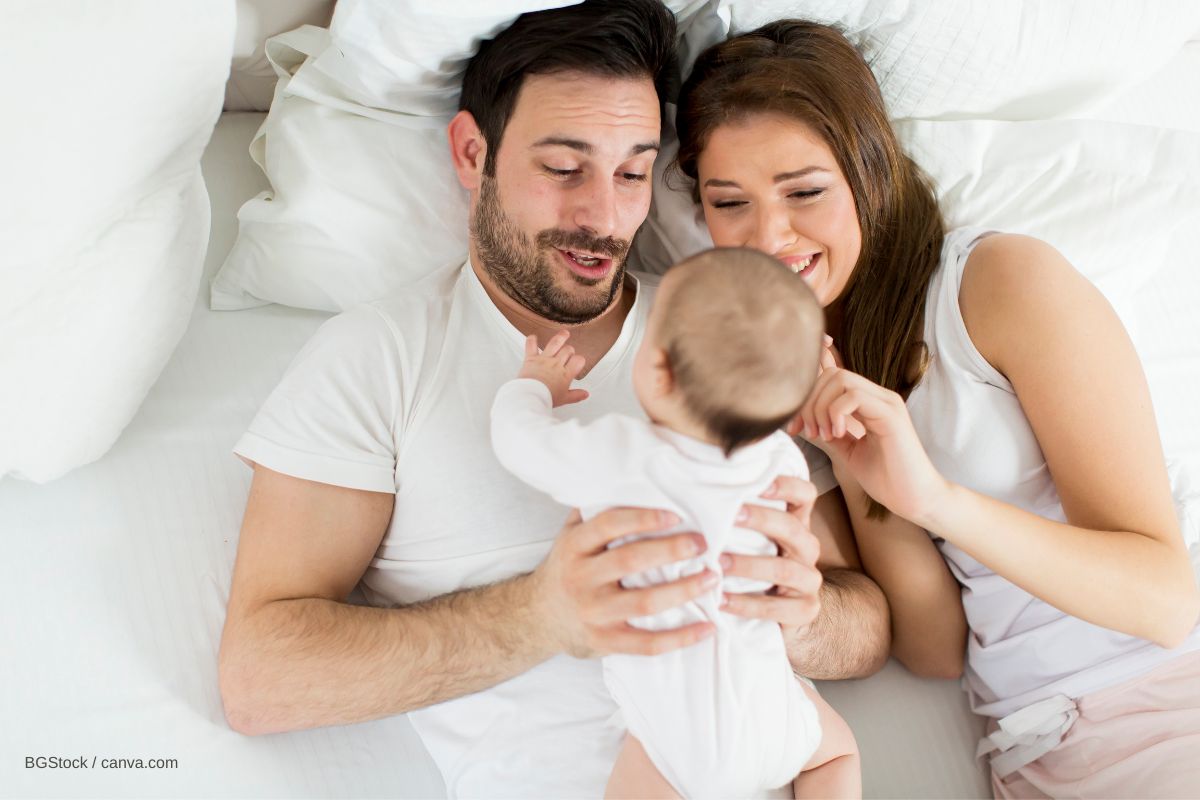Co-Sleeping im Familienbett: Vorteile & Nachteile

Co-sleeping is a topic that probably most parents are grappling with. The camps are divided: while some are convinced that their offspring are benefiting from the closeness of a family bed, others argue that the little ones should learn to sleep in their own cribs from an early age. But who is right? Here's everything you need to know about co-sleeping.
What is co-sleeping?
As new parents, you certainly want to do everything right so that your little one grows up sheltered. A central question is therefore how nights should be arranged. With co-sleeping, babies and children sleep in the immediate vicinity of both or one parent. This constellation is also called a family bed because the entire family shares a bed.
In evolutionary biology, co-sleeping was the norm for a long time in human history. After all, wild animals or harsh weather conditions made it unthinkable to put your baby or child down somewhere to sleep alone in the evening. In fact, the perception of young children and their sleep needs was fundamentally different from today's view of them as independent sleepers. Instead, the closeness and warmth of the parents were considered a prerequisite for the little ones to fall asleep comfortably. Today, we have come a long way from our beginnings and young children are equated with adults in their sleep needs. A separate nursery, complete with sleep aids such as mobiles and cuddly toys, is the norm for most children in the western world. Yet the needs of babies have not fundamentally changed. Little ones simply don't realize that their sleeping environment is safe and that their loving parents are sleeping just a door away.
What are the advantages of co-sleeping?
Co-sleeping in a family bed is symbolic of security and safety and strengthens basic trust. Especially in the first year, when they are getting to know the world and their parents intensively, babies and toddlers need the warmth and closeness of familiar people at night. This is the only way to give them adequate protection and teach them that their sleeping environment is safe. Sleeping in the family bed is therefore ideal for giving offspring the opportunity to build up sufficient trust. Children who grow up knowing that they are protected and loved, later develop into self-confident adults and have fewer problems forming close bonds with their peers.

Co-sleeping has many advantages – and not just for the little ones. Parents also benefit from having their own offspring in bed with them. It strengthens the parent-child bond and mothers in particular experience more restful sleep, as they worry less about their babies. Co-sleeping is also an ideal basis for effortless breastfeeding at night. Instead of having to get up, mom can simply stay lying down and continue sleeping right after breastfeeding.
Does co-sleeping have any disadvantages?
With so many advantages, it is initially surprising that there are parents who strictly reject co-sleeping. For one thing, they cite concerns for the safety of their offspring. However, the risk of sudden infant death syndrome is lower in a family bed than in a separate nursery, if well-known risk factors are avoided. But it is mainly the thought of spoiling one's own child that makes many parents unsure whether co-sleeping is right for them. It often helps to rely on your own intuition as a parent. If your child has built up enough trust after a while, the switch to his or her own bed often works out without any major problems. After all, the child now knows that mom and dad are always there when it needs them.
How co-sleeping works in a family bed
To make co-sleeping a safe and valuable experience for everyone involved, consider the following tips for getting a good night's sleep in your family bed.
- The main priority is the safety of your baby. It therefore needs a protected place in the family bed, where it can neither fall out of bed to the side nor be covered from both sides in the middle of the bed. A safe alternative is a side bed, in which the baby lies directly next to a parent but has its own lying surface and thus a protected place.

- Make sure that your family bed has a comfortable and sufficiently large lying surface. An annoying gap between the two mattresses is a particular hindrance when co-sleeping. Bridge this gap with a high-quality topper so that you can all dream together on a flat surface.
- It is safest for your baby to lie supine – on their back – during co-sleeping. As soon as you notice that your little one wants to adopt a different sleeping position, you should check that he or she can turn their head and breathe well.
- As long as you practice co-sleeping in the family bed, dogs and cats have no business in the bedroom, let alone the bed.
- Decorative pillows, cuddly toys, overly large and heavy blankets or pillows make the family bed less baby friendly. For the safety of your child, you should always put him or her in bed so high that you yourself would have to pull the blanket over your head to cover the baby's head.
- Small children are particularly sensitive. Therefore, when choosing bedding, look for high-quality, untreated natural materials. In summer, light summer bedding made of airy cotton fabrics is ideal. The mattress should also have a breathable cover so that you always enjoy a pleasant sleeping climate.
Photo credits:
BGStock / canva.com
Robert Kneschke / canva.com
Jacob Lund / canva.com
